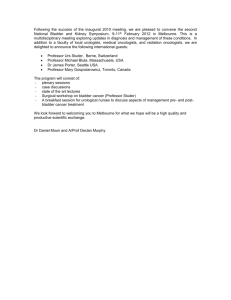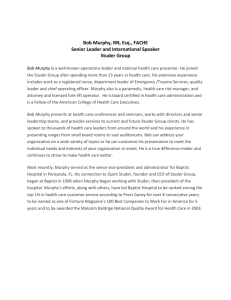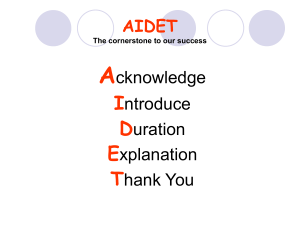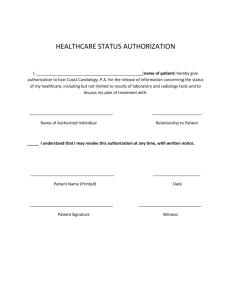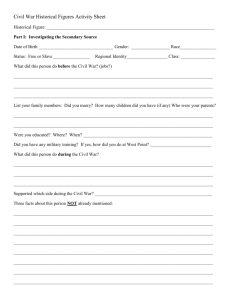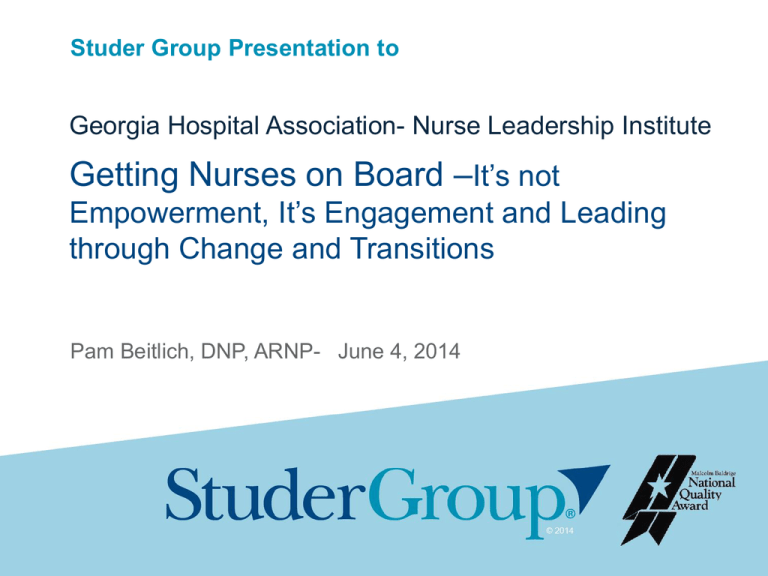
Studer Group Presentation to
Georgia Hospital Association- Nurse Leadership Institute
Getting Nurses on Board –It’s not
Empowerment, It’s Engagement and Leading
through Change and Transitions
Pam Beitlich, DNP, ARNP- June 4, 2014
Our Objectives 1. Examine the external changes in
healthcare
2. Understand one model of successful
change
3. Discuss the critical role every nurse
plays in the future of healthcare
Slide 2
COPYRIGHT © STUDER GROUP
Please do not quote or disseminate without Studer Group authorization
What are:
Two things you can
start tomorrow that
will make you more
effective in
transitioning through
healthcare change?
Slide 3
COPYRIGHT © STUDER GROUP
Please do not quote or disseminate without Studer Group authorization
Slide 4
COPYRIGHT © STUDER GROUP
Please do not quote or disseminate without Studer Group authorization
So….How’s Your Day Going?
Slide 5
COPYRIGHT © STUDER GROUP
Please do not quote or disseminate without Studer Group authorization
Slide 6
COPYRIGHT © STUDER GROUP
Please do not quote or disseminate without Studer Group authorization
Slide 7
COPYRIGHT © STUDER GROUP
Please do not quote or disseminate without Studer Group authorization
Slide 8
COPYRIGHT © STUDER GROUP
Please do not quote or disseminate without Studer Group authorization
Everything Starts Here..
Your Mission
Your Vision
Your Values
Organizationally and Personally
Slide 9
COPYRIGHT © STUDER GROUP
Please do not quote or disseminate without Studer Group authorization
Studer Group Mission and Vision
Mission:
To make healthcare a better place for
employees to work, physicians to
practice medicine and patients to
receive care.
Vision:
To be the intellectual resource for
healthcare professionals, combining
passion with prescriptive actions and
tools, to drive outcomes and maximize
the human potential within each
organization and healthcare as a whole.
The Our Foundation
Slide 11
COPYRIGHT © STUDER GROUP
Please do not quote or disseminate without Studer Group authorization
Execution Framework
Evidence-Based LeadershipSM
Page 12
COPYRIGHT © STUDER GROUP
Please do not quote or disseminate without Studer Group authorization
Healthcare Flywheel®
Page 13
COPYRIGHT © STUDER GROUP
Please do not quote or disseminate without Studer Group authorization
Building a Culture of High Performance
The External Environment
Slide 14
COPYRIGHT © STUDER GROUP
Please do not quote or disseminate without Studer Group authorization
Significant Changes in Healthcare
Over the Last Decade
Transparency/Public reporting/Consumer
Technology
Research
Integration
Additional Market Changes
Episodic vs. Continuous Change
Page 15
COPYRIGHT © STUDER GROUP
Please do not quote or disseminate without Studer Group authorization
Healthcare over the Last Decade
Disruptive Change – Payment
Page 16
COPYRIGHT © STUDER GROUP
Please do not quote or disseminate without Studer Group authorization
Over the Next Decade, Hospital Margins
Are Expected to Decline Sharply
Hospital operating margins
2.2%
2011
2013
2015
With proposed
reimbursement cuts,
2.2% will become a
16.8% deficit.
Page 17
2017
2019
2021
-16.8%
COPYRIGHT © STUDER GROUP
Please do not quote or disseminate without Studer Group authorization
The Value Equation -
Slide 18
COPYRIGHT © STUDER GROUP
Please do not quote or disseminate without Studer Group authorization
What is Reform really about?
Healthier population
Lower Use
Lower Prices
Higher quality
$/N
2013
Time
Reference: Seeing Beyond Reform: Governance and the Emerging New Healthcare; James Orlikoff, President; Orlikoff & Associates, Inc.; 4800 S. Chicago
Beach Drive; Suite 307N; Chicago Il 60615-2054; 773-268-8009; j.orlikoff@att.net
Slide 19
Len Nichols, George
Mason University
COPYRIGHT © STUDER GROUP
Please do not quote or disseminate without Studer Group authorization
Being a leader in healthcare
today is like continuously
walking up a down escalator.
If one stands still they go
backwards.
Slide 20
COPYRIGHT © STUDER GROUP
Please do not quote or disseminate without Studer Group authorization
The New Health Age -
“We live in a moment of history where change is
so speeded up that we begin to see the present
only when it is already disappearing.”
-R.D. Laing
Slide 21
COPYRIGHT © STUDER GROUP
Please do not quote or disseminate without Studer Group authorization
Reimbursement changes, technology
changes, procedures change, medications
change, events and people change. The
most important skill is to create a culture that
has the agility and ability to adapt to the
changes.
Slide 22
COPYRIGHT © STUDER GROUP
Please do not quote or disseminate without Studer Group authorization
Change today happens Quickly..
No longer short periods of change, followed by
long plateaus of stability
Continual, unrelenting series of changes, with
little time for self-renewal
Keeping energized, optimistic and inspired in the
face of change demands specific skills
You need to learn how to respond quickly and
flexibly to new demands
Slide 23
COPYRIGHT © STUDER GROUP
Please do not quote or disseminate without Studer Group authorization
Myths
Patients: They have unrealistic expectations
Staff: Leaders job is to get everyone on board
Physicians: It is impossible to get physicians
aligned
Leadership: Engagement of people and patient
experience are soft skills
Data: Low “n” – means the data isn’t useful
Easy: Seems common sense so it is simple
Slide 24
COPYRIGHT © STUDER GROUP
Please do not quote or disseminate without Studer Group authorization
Observations
No victim thinking
Control our own destiny
People need you
You not only save lives but you save healthcare
Slide 25
COPYRIGHT © STUDER GROUP
Please do not quote or disseminate without Studer Group authorization
Execution Triangle
Page 26
COPYRIGHT © STUDER GROUP
Please do not quote or disseminate without Studer Group authorization
Top Ten Challenges in Execution
1. Leaders / Others
underperforming and still
receiving a good evaluation
2. Change not connected to
why
3. Lack of necessary urgency
4. Leaders do not have the
skills to assure a solid
implementation
6. Push Back by leaders,
staff and physicians
7. Not familiar with what
“right” looks like
8. Lack of frequency
9. Inability to transfer best
practices
10. Poor processes
5. Too many changes -- too
soon
Slide 27
COPYRIGHT © STUDER GROUP
Please do not quote or disseminate without Studer Group authorization
High Performance Organization - 2013
Assesses
Organizations in
Six Key Areas
4 years of data
2009-2013
35,633 leader
responses
More than 500
healthcare
systems
Page 28
COPYRIGHT © STUDER GROUP
Please do not quote or disseminate without Studer Group authorization
"Culture outperforms strategy
every time; and culture with
strategy is unbeatable."
-Quint Studer
Page 29
COPYRIGHT © STUDER GROUP
Please do not quote or disseminate without Studer Group authorization
Building a Culture of High Performance
Leading Change
Slide 30
COPYRIGHT © STUDER GROUP
Please do not quote or disseminate without Studer Group authorization
Critical Elements of Successful Change
Compelling reason for change to achieve
something better
Leadership commitment to support the change
Active engagement of staff
Alignment with mission, goals, resources
Connections and collaboration across
boundaries (silos)
Effective communication techniques that inform
and inspire to elicit an emotional response
-VanDeusen Lukas et al (2007), Kotter, 2002)
Slide 31
COPYRIGHT © STUDER GROUP
Please do not quote or disseminate without Studer Group authorization
Most Change Efforts Fail
Total Quality Management programs:
–About two-thirds “grind to a halt
because of their failure to produce
the hoped-for results”
Reengineering
–70% failure rate
Kotter, John P. 1995. Leading Change: Why Transformation Efforts Fail.
Harvard Business Review. 73(2): 59-67.
Slide 32
COPYRIGHT © STUDER GROUP
Please do not quote or disseminate without Studer Group authorization
“Highly successful organizations know how
to overcome antibodies that reject anything
new. But first, a process of change must
happen that uses both the head and the
heart.”
Slide 33
COPYRIGHT © STUDER GROUP
Please do not quote or disseminate without Studer Group authorization
Change and Emotions -
“It’s not so much that we’re afraid of change or so
in love with the old ways, but it’s that place in
between that we fear…It’s like being between
trapezes. It’s Linus when his blanket is in the
dryer. There’s nothing to hold on to.”
- Marilyn Ferguson, Futurist
Slide 34
COPYRIGHT © STUDER GROUP
Please do not quote or disseminate without Studer Group authorization
When Changing Behavior, both thinking
and feeling are Essential
Thinking Differently
1. Analyze - Give the data and the
evidence
2. Think – Data and analysis
influence how we think
3. Change – New thoughts can
change or reinforce changed
behavior
Slide 35
COPYRIGHT © STUDER GROUP
Please do not quote or disseminate without Studer Group authorization
Behavior changes when we Feel…
Feeling differently 1. See – help people “see” by
creating surprising and
compelling visual experiences
2. Feel – seeing something new
hits the emotions
3. Change – emotionally charged
ideas change behavior
Slide 36
COPYRIGHT © STUDER GROUP
Please do not quote or disseminate without Studer Group authorization
Key Skills for Leading Change
Why, What and How
Burning Platform
Critical Mass
Creating the Right Amount of Tension
Success Steps
Don’t Declare Victory
Slide 37
COPYRIGHT © STUDER GROUP
Please do not quote or disseminate without Studer Group authorization
Leader’s Role is Multi-faceted..
Motivator
Collaborator
Advisor
Consultant
Planner
Counselor
Evaluator
Educator
Slide 38
Facilitator
COPYRIGHT © STUDER GROUP
Please do not quote or disseminate without Studer Group authorization
Leading Change
Operational Framework
Managing Individual and Change
Managing Organizations and Change
Slide 39
COPYRIGHT © STUDER GROUP
Please do not quote or disseminate without Studer Group authorization
Kotter’s Eight-Stage Change Process
Slide 40
COPYRIGHT © STUDER GROUP
Please do not quote or disseminate without Studer Group authorization
Creating the Climate for Change
1. Create a
sense of
urgency
2. Create the
guiding team
3. Develop a
change vision
and strategy
Help others feel a gut-level
determination to act, now
Put together a group with enough
power and skills to lead the change
Clarify how the future will be
different from the past
Slide 41
COPYRIGHT © STUDER GROUP
Please do not quote or disseminate without Studer Group authorization
The biggest obstacle
in achieving high performance is not
achieving the needed
urgency for change.
Kotter, John P (2008)
A Sense of Urgency.
United States: Harvard
Business Review Press.
Slide 42
COPYRIGHT © STUDER GROUP
Please do not quote or disseminate without Studer Group authorization
“People wish to be
settled; but only as far
as they are unsettled,
is there any hope for
them.”
—Ralph Waldo Emerson
Slide 43
COPYRIGHT © STUDER GROUP
Please do not quote or disseminate without Studer Group authorization
Your Vision - Six Key Characteristics
Imaginable
Desirable
Communicable
Vision
Feasible
Flexible
Focused
Slide 44
COPYRIGHT © STUDER GROUP
Please do not quote or disseminate without Studer Group authorization
Communicate your Vision - “Signal Loss”
CEO to VP: Today at 11:00 there will be a total eclipse of the sun. This is when the sun
disappears behind the moon for 2 minutes. This is something that cannot be seen
everyday. Time will be allowed for employees to view the eclipse in the parking lot at ten
till 11, when I will deliver a short speech introducing the eclipse and giving some
background information. Safety goggles will be made available at a small cost.
VP to Director: Today at 10 till 11 all staff should meet in the parking lot. This will be
followed by a total eclipse of the sun, which will disappear for two minutes. For a
moderate cost, this will be made safe with goggles. The CEO will deliver a short speech
beforehand to give us all some background information. This is not something that can
be seen every day.
Director to Manager: Today the CEO will deliver a short speech to make the sun
disappear for 2 minutes in an eclipse. This is something that cannot be seen everyday,
so people will meet in the parking lot at 10 or 11. This will be safe, if you pay a moderate
cost.
Manager to Supervisor: Ten or eleven staff are to go to the parking lot where the CEO
will eclipse the sun for 2 minutes. This doesn’t happen every day. It will be safe, but it
will cost you.
Supervisor to Employees: Some employees will go to the parking lot today to see the
CEO disappear. It is a pity this doesn’t happen every day.
Contributed to Swenny's E-mail Funnies by Ajay Ambastha, Mumbai, India
Slide 45
COPYRIGHT © STUDER GROUP
Please do not quote or disseminate without Studer Group authorization
Creating the Climate
1. How will you create a sense of urgency?
2. Who needs to be on the team? What types of
skills are needed?
3. Consider a graphical depiction of your vision
Slide 46
COPYRIGHT © STUDER GROUP
Please do not quote or disseminate without Studer Group authorization
Engaging and Enabling the Organization
4.
Communicate
the vision for
buy-in
Make sure stakeholders understand
and accept the vision and strategy
5. Empower
broad-based
action
Remove as many barriers as possible
and unleashing people to do their best
6. Generate
short term
wins
Create visible success ASAP
Slide 47
COPYRIGHT © STUDER GROUP
Please do not quote or disseminate without Studer Group authorization
Adoption of Change Occurs over Time
- Rogers
Slide 48
COPYRIGHT © STUDER GROUP
Please do not quote or disseminate without Studer Group authorization
5. Empowering People to Effect Change
Communicate a sensible vision
Make structure compatible with the vision
Provide the training employees need
Align information and personnel systems
Confront supervisors who undercut needed
change
Slide 49
COPYRIGHT © STUDER GROUP
Please do not quote or disseminate without Studer Group authorization
6. Create Visible Successes
Change takes time. High risk for loss of momentum
and the onset of disappointment.
Most people won’t go on a long march for change
unless they begin to see compelling evidence that
their efforts are bearing fruit.
Balance “preparing for” and “implementing”
PLAN short-term gains, hit them, celebrate them.
Don’t just hope for them.
Commitments to produce short-term wins help keep
the urgency level up.
Slide 50
COPYRIGHT © STUDER GROUP
Please do not quote or disseminate without Studer Group authorization
Enabling and Engaging 4) What strategies will you use to communicate
the vision and change strategy?
–Create a surprising, compelling, or visual
experience to communicate
5) How will you empower staff?
6) How will you celebrate short term wins?
51
Slide 51
COPYRIGHT © STUDER GROUP
Please do not quote or disseminate without Studer Group authorization
Implementing and Sustaining Change
7. Don’t let
up
Maintain momentum. Consolidate
gains and produce more change until
the vision is a reality.
8. Make
the change
stick
Anchor new approaches in the culture
for sustained change.
Slide 52
COPYRIGHT © STUDER GROUP
Please do not quote or disseminate without Studer Group authorization
7. Consolidate Gains & Create more
Change
Don’t declare victory too soon – kills momentum. Old
traditions reclaim ground.
Can take 5-10 years to sink deeply into a culture
New approaches are fragile and subject to
regression
Use the feeling of victory as the motivation:
– to expose opportunities for more tuning
– to move people committed to the new ways into key
roles
Slide 53
COPYRIGHT © STUDER GROUP
Please do not quote or disseminate without Studer Group authorization
Implementing and Sustaining
7. What strategies will you use to maintain early
momentum?
8. How will you reinforce the early adopters and
encourage further adoption?
54
Slide 54
COPYRIGHT © STUDER GROUP
Please do not quote or disseminate without Studer Group authorization
Which Phase is Biggest Opportunity?
Slide 55
COPYRIGHT © STUDER GROUP
Please do not quote or disseminate without Studer Group authorization
Differentiating Competencies 1. Character
4. Interpersonal Skills
High integrity and honesty
Communicates powerfully and
prolifically
2. Personal Capability
Inspires/motivates others to high
performance
Technical /Professional Expertise
Solves problems /Analyzes Issues
Builds relationships
Innovates
Develops others
Practices self development
Collaboration / Teamwork
3. Focus on Results
5. Leading Change
Drives for results
Develops strategic perspective
Establishes stretch goals
Champions change
Takes initiative
Connects the team to the outside
world
- Zenger | Folkman Company, 2006
Slide 56
COPYRIGHT © STUDER GROUP
Please do not quote or disseminate without Studer Group authorization
Managing Reactions to Change
Understand how
people react to
change
Apply strategies for
managing reactions
Slide 57
COPYRIGHT © STUDER GROUP
Please do not quote or disseminate without Studer Group authorization
Transition – the Emotional Process
Most people don’t fear change, but the loss that
comes with it
Stages are characterized with typical reactions –
normal and healthy
Impact can include grief, denial, anger,
bargaining, guilt, depression and acceptance
Includes chaos and loss of equilibrium
Includes regaining balance and a new beginning
Helps us prepare and plan how to take care of
ourselves
Slide 58
COPYRIGHT © STUDER GROUP
Please do not quote or disseminate without Studer Group authorization
Change vs. Transition
Slide 59
COPYRIGHT © STUDER GROUP
Please do not quote or disseminate without Studer Group authorization
Successful Transition Through Change Letting go of what’s old and familiar
Sitting with what’s unknown and uncertain YET
avoiding the “learned helplessness syndrome”
Adjusting to what’s new and unfamiliar
We all have multiple experiences of change
Slide 60
COPYRIGHT © STUDER GROUP
Please do not quote or disseminate without Studer Group authorization
Responding to Stakeholder Feelings
Positive
• Channel the energy
• Beware of groupthink
• Name the problem of
mixed emotions
• Create a safe
environment
Ambivalent
• Help people make
sense of the proposed
change
• Actively engage in
meaningful discussion
• Listen for information
that may be helpful
• Address concerns
Negative
• Use two way
communication
• Keep people informed
about when, where,
how
• Keep surprises to a
minimum with regular
communication
• Anticipate questions
and concerns
• Publicize successful
change and progress
• Offer hope and
direction
Tip: Invest Time and Energy at the front end of the change to
manage reactions
Cawsey, Deszca, Ingols (2012)
Slide 61
COPYRIGHT © STUDER GROUP
Please do not quote or disseminate without Studer Group authorization
Change not always bad or feared
Slide 62
COPYRIGHT © STUDER GROUP
Please do not quote or disseminate without Studer Group authorization
Phases of Competency and Change
Individual
Unconsciously
unskilled
Slide 63
Source: Abraham Maslow; 1940; “Four Stages for Learning Any New
Skill””; Gordon Training International by Noel Burch; 1970
COPYRIGHT © STUDER GROUP
Please do not quote or disseminate without Studer Group authorization
Phases of Competency and Change
Individual
Consciously
unskilled
Unconsciously
unskilled
Page 64
Source: Abraham Maslow; 1940; “Four Stages for Learning Any New
Skill””; Gordon Training International by Noel Burch; 1970
COPYRIGHT © STUDER GROUP
Please do not quote or disseminate without Studer Group authorization
Phases of Competency and Change
Individual
Consciously
skilled
Consciously
unskilled
Unconsciously
unskilled
Source: Abraham Maslow; 1940; “Four Stages for Learning Any New
Skill””; Gordon Training International by Noel Burch; 1970
Slide 65
COPYRIGHT © STUDER GROUP
Please do not quote or disseminate without Studer Group authorization
Phases of Competency and Change
Individual
Unconsciously
skilled
Consciously
skilled
Consciously
unskilled
Unconsciously
unskilled
Source: Abraham Maslow; 1940; “Four Stages for Learning Any New
Skill””; Gordon Training International by Noel Burch; 1970
Slide 66
COPYRIGHT © STUDER GROUP
Please do not quote or disseminate without Studer Group authorization
Phases of Competency and Change
Individual
Unconsciously
skilled
Consciously
skilled
Consciously
unskilled
Unconsciously
unskilled
Source: Abraham Maslow; 1940; “Four Stages for Learning Any New
Skill””; Gordon Training International by Noel Burch; 1970
Slide 67
COPYRIGHT © STUDER GROUP
Please do not quote or disseminate without Studer Group authorization
Phases of Change - Organization
PHASE 1
THE HONEYMOON
Sense of excitement
Right “to do” list
Things will get better (hope)
Quick fixes are implemented
Skeptics
Slide 68
COPYRIGHT © STUDER GROUP
Please do not quote or disseminate without Studer Group authorization
Phases of Change - Organization
PHASE 2
REALITY SETS IN
We/they
Inconsistency
Bigger than I thought
This will impact me
Some are getting it
Some are not
Slide 69
COPYRIGHT © STUDER GROUP
Please do not quote or disseminate without Studer Group authorization
Phases of Change - Organization
PHASE 3
THE UNCOMFORTABLE GAP
Performance gap is evident
Tougher decisions must be made
Process improvement increases
Inconsistencies obvious
Slide 70
COPYRIGHT © STUDER GROUP
Please do not quote or disseminate without Studer Group authorization
Source: The Right Stuff Movie
Chuck Yeager
Slide 71
COPYRIGHT © STUDER GROUP
Please do not quote or disseminate without Studer Group authorization
Phases of Change - Organization
PHASE 4
CONSISTENCY
High performing results
Everyone understands the keys to success
Disciplined people and disciplined
processes
Proactive leadership
Slide 72
COPYRIGHT © STUDER GROUP
Please do not quote or disseminate without Studer Group authorization
Most Trusted, Least Engaged
Slide 73
COPYRIGHT © STUDER GROUP
Please do not quote or disseminate without Studer Group authorization
“Rate honesty and ethical standards of people
in these fields”
100
90
80
70
60
50
40
30
20
10
0
% Responses "High" and "Very High"
85
75
70
70
62
58
53
52
41
38
28
24
10
8
Gallup Poll: http://www.gallup.com/poll/159035/congress-retains-low-honesty-rating.aspx
Slide 74
COPYRIGHT © STUDER GROUP
Please do not quote or disseminate without Studer Group authorization
Least Happy
Nursing rated #2 least happy profession
– Compensation,
– Growth opportunities
– Workplace culture
“Nurses have more issues with the culture of
their workplaces, the people they work with, and
the person they work for”
CareerBliss.com released list based on analysis of 100,400+ employees, 2011-2012
Slide 75
COPYRIGHT © STUDER GROUP
Please do not quote or disseminate without Studer Group authorization
Engagement is Critical Staff who have the most patient contact are
often the least satisfied and engaged
There is a strong correlation between patient
satisfaction and staff engagement. Hospitals
that can provide the best environment for
employees will be rewarded with better patient
care.
- Press Ganey, 2010
Slide 76
COPYRIGHT © STUDER GROUP
Please do not quote or disseminate without Studer Group authorization
Owner vs. Renter
Is this an OWNER?
Slide 78
COPYRIGHT © STUDER GROUP
Please do not quote or disseminate without Studer Group authorization
Slide 80
COPYRIGHT © STUDER GROUP
Please do not quote or disseminate without Studer Group authorization
As Little Work as Possible?
Slide 81
COPYRIGHT © STUDER GROUP
Please do not quote or disseminate without Studer Group authorization
Missed the WHY?
Slide 82
COPYRIGHT © STUDER GROUP
Please do not quote or disseminate without Studer Group authorization
WHY this all Matters…
Slide 83
COPYRIGHT © STUDER GROUP
Please do not quote or disseminate without Studer Group authorization
Engaged Work Environments Engaged – work with passion and feel a profound
connection to their company, drive innovation and move
the company forward
Not-engaged – essentially “checked-out” or sleepwalking through their day, putting time in but not energy
or passion in their work
Actively dis-engaged- not only unhappy at work but
actively acting out their unhappiness. Every day these
workers undermine what their engaged co-workers
accomplish.
-Gallup
Slide 84
COPYRIGHT © STUDER GROUP
Please do not quote or disseminate without Studer Group authorization
Everyone thinks of
changing the world, but no
one thinks of changing
himself
- Leo Tolstoy
Slide 85
COPYRIGHT © STUDER GROUP
Please do not quote or disseminate without Studer Group authorization
Slide 86
COPYRIGHT © STUDER GROUP
Please do not quote or disseminate without Studer Group authorization
Employee Engagement and Safety Link
Conclusion:
Employees with low
engagement are more
likely to work around
safety protocols, but are
less likely to work around
safety protocols when
highly engaged
Work arounds
4
3.5
3
2.5
2
Low Engagement
High Engagement
Source: Leadership, Rework, and Workarounds; Grant T. Savage, Ph.D.; University of Alabama at Birmingham, February 2011
Page 87
COPYRIGHT © STUDER GROUP
Please do not quote or disseminate without Studer Group authorization
Interdependent Relationships
Quality Example
Relationship Between Employee Turnover and Patient Care
* Average Length of Stay
Source: VHA
Page 88
COPYRIGHT © STUDER GROUP
Please do not quote or disseminate without Studer Group authorization
Patients’ Perception of Care = Quality
Vascular Catheter-Associated Infection
Patients’ Perception of Care = Quality
Pressure Ulcer Stages III and IV
Healthcare became really Personal…
Slide 91
COPYRIGHT © STUDER GROUP
Please do not quote or disseminate without Studer Group authorization
Can you Connect?
All of us must first feel inspired, engaged, and
connected before able to give our best work.
Without a connection, we will still work, but
not as well as needed or desired.
Connection truly is a distinguishing factor.
Slide 92
COPYRIGHT © STUDER GROUP
Please do not quote or disseminate without Studer Group authorization
Would a Consumer Choose You?
83 % of consumers are very/somewhat concerned
about hospital quality
93.8 % reported being willing to go out of their way
(drive further, reschedule appointments) and 64.9%
said they would pay more to seek care at a more
highly-rated hospital
57 % believe online hospital quality ratings are a
trustworthy source of information
60.7 % feel the federal government should pay
highly-performing hospitals more
Source: HealthGrades, Inc. 2010 survey
Slide 93
COPYRIGHT © STUDER GROUP
Please do not quote or disseminate without Studer Group authorization
Behavior Standards are So Important
Patients want to be
cared for by a friendly,
caring, and
empathetic team
Slide 94
COPYRIGHT © STUDER GROUP
Please do not quote or disseminate without Studer Group authorization
Slide 95
COPYRIGHT © STUDER GROUP
Please do not quote or disseminate without Studer Group authorization
Swim Instructor versus Life Guard
Slide 96
COPYRIGHT © STUDER GROUP
Please do not quote or disseminate without Studer Group authorization
Coaching versus Criticism
Slide 97
COPYRIGHT © STUDER GROUP
Please do not quote or disseminate without Studer Group authorization
Mandatory vs. Optional - A Culture of
“Optionality”
Slide 98
COPYRIGHT © STUDER GROUP
Please do not quote or disseminate without Studer Group authorization
How do YOU respond to Change?
Slide 99
COPYRIGHT © STUDER GROUP
Please do not quote or disseminate without Studer Group authorization
Change Resiliency Positive
Organized
Flexible
Focused
Proactive
-A Change for the Better, Daryl R. Connor
Slide 100
COPYRIGHT © STUDER GROUP
Please do not quote or disseminate without Studer Group authorization
Those that Deal Well with Change Strong support system/seek support
Sense of control over their lives
Positive outlook
High self-esteem
See change as a challenge/opportunity
Committed and involved
Have an internal belief/value system to
experience change within an overall philosophy
Slide 101
COPYRIGHT © STUDER GROUP
Please do not quote or disseminate without Studer Group authorization
“Psychologically Hardy” Recognize Choices – stressful life events as
interesting; separate out thoughts and emotions
Engagement – work hard to influence part of the
stressor
Growth – situation is an opportunity to develop
and grow
Slide 102
COPYRIGHT © STUDER GROUP
Please do not quote or disseminate without Studer Group authorization
Good Leadership is Critical…
Slide 103
COPYRIGHT © STUDER GROUP
Please do not quote or disseminate without Studer Group authorization
What draws people to Leaders?
Trust
Compassion
Stability
Hope
Slide 104
COPYRIGHT © STUDER GROUP
Please do not quote or disseminate without Studer Group authorization
Connecting Heart and Mind
Heart
Slide 105
Mind
COPYRIGHT © STUDER GROUP
Please do not quote or disseminate without Studer Group authorization
Communicating: The Suggested Sequence
Why
What
How
Slide 106
COPYRIGHT © STUDER GROUP
Please do not quote or disseminate without Studer Group authorization
Speak to the Head and Heart
Create a compelling story
- Use metaphors, analogies, imagery
- Use simple language
Careful use of data
Infuse energy and enthusiasm
Understand what people are feeling
Frequent, consistent, aligned
communication
Maintain high level of visibility
Slide 107
COPYRIGHT © STUDER GROUP
Please do not quote or disseminate without Studer Group authorization
Principles of Influence Self-Awareness: the basic competency of
influence
Collaboration: the duty of influence, at its core,
is about getting a group of people to accomplish
something that one person cannot do alone
Connection: the strategy of influence
Slide 108
COPYRIGHT © STUDER GROUP
Please do not quote or disseminate without Studer Group authorization
You cannot take your Organization
Further than you have taken Yourself
Slide 109
COPYRIGHT © STUDER GROUP
Please do not quote or disseminate without Studer Group authorization
Characteristics of Effective Leaders..
Cared about us
Gave honest feedback
Developed our skills
Coached our performance
Celebrated our success
…….Good Communicators
Slide 110
COPYRIGHT © STUDER GROUP
Please do not quote or disseminate without Studer Group authorization
Navigating Change -
Some is not a number,
soon is not a time,
and hope is not a plan
Slide 111
COPYRIGHT © STUDER GROUP
Please do not quote or disseminate without Studer Group authorization
Words Mean Things…
Slide 112
COPYRIGHT © STUDER GROUP
Please do not quote or disseminate without Studer Group authorization
The Leader’s Role in Navigating through
Transitions
Before
After
During
Round on your Team and Ask- How are you doing?
- What are you thinking?
- How are you feeling?
- What’s working?
- What’s not working?
- How can I help?
Rounding on patients
Thank You’s and Recognition
Slide 113
COPYRIGHT © STUDER GROUP
Please do not quote or disseminate without Studer Group authorization
Create a Learning Organization Culture
• Create organizational agility and
resiliency
• Encourage pilot programs
• Build organizational alignment
around values and culture
• Encourage staff to be change
agents
Slide 114
COPYRIGHT © STUDER GROUP
Please do not quote or disseminate without Studer Group authorization
Assist the Skeptics and the Laggards They dislike uncertainty
Often the last to adopt
Point of reference may only be the past
Little tolerance for uncertainty
Suspicious of innovation and change agents
Slide 115
COPYRIGHT © STUDER GROUP
Please do not quote or disseminate without Studer Group authorization
Employees Cope Better Feel same level of commitment, control and
challenge as their leaders
Understand that change is important
Believe they can influence decisions and
outcomes
Experience the journey not as a threat but an
adventure
Leadership from top down must create conditions
to make that possible
- Bridges, Managing Transitions
Slide 116
COPYRIGHT © STUDER GROUP
Please do not quote or disseminate without Studer Group authorization
Reactions to Change are Personal
Consider 3 or 4 changes you have experienced1. What was the change and how was it introduced?
2. What was your initial reaction?
Enthusiasm?
“Wait and see” attitude?
Ambivalence?
Cynicism?
3. Did your attitudes change over time?
4. Was there a pattern to your response?
5. If you experienced ambivalence, how did you resolve it?
6. How have these experiences colored your expectations
and feelings toward change in the future?
Slide 117
COPYRIGHT © STUDER GROUP
Please do not quote or disseminate without Studer Group authorization
Manage your Energy-
Physical energy:
you are a resource
Emotional energy:
the quality of your
energy
Slide 118
COPYRIGHT © STUDER GROUP
Please do not quote or disseminate without Studer Group authorization
Manage your Energy
Mental energy: it’s all in your head
Spiritual energy: connecting to
purpose
Slide 119
COPYRIGHT © STUDER GROUP
Please do not quote or disseminate without Studer Group authorization
Remember Nursing expertise and leadership in
healthcare today is more critical than
ever
Stay flexible and positive through
lightning speed change
Maximize your energy
Make an action plan
Slide 120
COPYRIGHT © STUDER GROUP
Please do not quote or disseminate without Studer Group authorization
What has Changed in Healthcare?
External Environment
Technology
Transparency
Research
Integration
Quint Studer – Culture of High Performance
Slide 121
COPYRIGHT © STUDER GROUP
Please do not quote or disseminate without Studer Group authorization
Slide 122
COPYRIGHT © STUDER GROUP
Please do not quote or disseminate without Studer Group authorization
What has remained Constant in
Healthcare?
Passion
Fortitude
Willingness to learn
Purpose, worthwhile work and making a
difference
Quint Studer – Culture of High Performance
Slide 123
COPYRIGHT © STUDER GROUP
Please do not quote or disseminate without Studer Group authorization
Become a Champion of Change..
and Inspire as you Lead
Slide 124
COPYRIGHT © STUDER GROUP
Please do not quote or disseminate without Studer Group authorization
Our Objectives 1. Examine the external changes in
healthcare
2. Understand one model of successful
change
3. Discuss the critical role every nurse
plays in the future of healthcare
Slide 125
COPYRIGHT © STUDER GROUP
Please do not quote or disseminate without Studer Group authorization
What are:
Two things you can
start tomorrow that
will make you more
effective to inspire
and lead through
change?
Slide 126
COPYRIGHT © STUDER GROUP
Please do not quote or disseminate without Studer Group authorization
We all Make a Difference…
Slide 127
COPYRIGHT © STUDER GROUP
Please do not quote or disseminate without Studer Group authorization
Purpose and Worthwhile Work...
Our patients depend on us and
we depend on you. Yours might
be the first face they see when
they come through our door.
Yours might be the voice they
hear right after a surprise
diagnosis. Yours might be the
eyes they look into as they are
pushed in a wheelchair to a
frightening procedure. Your
attitude reflects us and everything
we are proud of in this
organization. You have chosen to
help serve our patients and we
appreciate you. Thank you.
Slide 128
COPYRIGHT © STUDER GROUP
Please do not quote or disseminate without Studer Group authorization
Parting Thought -
“If you want to go fast, go alone. If
you want to go far,
go together”
- African Proverb
Slide 129
COPYRIGHT © STUDER GROUP
Please do not quote or disseminate without Studer Group authorization
Thank You!
Pam Beitlich
www.studergroup.com
(850) 934-1099
Slide 130
COPYRIGHT © STUDER GROUP
Please do not quote or disseminate without Studer Group authorization
References and Resources
Balogun, J. & Johnson, G. (2005). From intended strategies to unintended outcomes: The impact of
change recipient sensemaking. Organizational Studies, 26(11), 1596.
Bridges, W. (2003). Managing Transitions: Making the most of change. (2 nd Ed.).
Cawsey, T. Deszca, G., Ingols, C. (2011). Organizational Change: An action oriented toolkit.
Thousand Oaks, CA: Sage.
Kotter, J. P. (1996). Leading change. Boston: Harvard Business Press.
Kotter, J.P. (2002). The heart of change. Boston: Harvard Business Press.
Kotter International (2012). Retrieved from: http://www.kotterinternational.com/ourprinciples/changesteps/changesteps
Ritter, J. (2012). Resistance to change and change management. In N. Borkowski (Ed.),
Organizational behavior in health care (pp. 373-397). Boston: Jones & Bartlett.
Zenger | Folkman Company. All rights reserved. UWMC.PM-CCDG.EL4.0 Rev 05.02.06
Slide 131
COPYRIGHT © STUDER GROUP
Please do not quote or disseminate without Studer Group authorization

